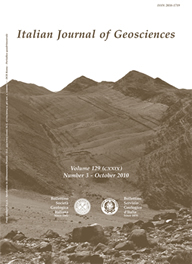
A revision of the stratigraphy and geology of the south-western part of the Crotone Basin (South Italy)
Francesco Massari(*), Giacomo Prosser(**), Luca Capraro(*), Eliana Fornaciari(*), Chiara Consolaro(***) & (*)
(*) Dipartimento di Geoscienze, Università di Padova, Via Giotto, 1 - 35137 Padova, Italy. francesco.massari@unipd.it.
(**) Dipartimento di Scienze Geologiche, Università della Basilicata, Campus Macchia Romana - 85100 Potenza.
(***) University of Tromsø, Department of Geology, Drams - veien 201, N-9037 Tromsø, Norway.
Volume: 129 (2010) f.3
Pages: 353-384
Abstract
The Crotone Basin, located on a stack of nappes piled up during the late Paleogene-Neogene, formed in the late Neogene to Quaternary as a forearc basin of the Ionian arc-trench system. The process of slab rollback caused rapid trench migration, resulting in an extensionaltranstensional regime persisting most of the time in the forearc area.
The late Neogene tectonic evolution was strongly influenced by a NW-directed fault system, interpreted as basement wrench faults leading to partitioning of the basin into separate sub-basins subject to differential subsidence and mutual displacements. Major sequences identified in the area are regarded as tectono-stratigraphic sequences (TSS). The first of them was laid down in the late Serravallian (?) - Tortonian - early Messinian, during the basin opening stage and is bounded at the top by an erosional unconformity, which may be correlated with the well-known intra-Messinian event of the Mediterranean Salinity Crisis. The second TSS, of middle to late Messinian age, is characterized by strongly syntectonic deposits mostly derived from cannibalization of the lower Messinian
succession, first infilling extensional troughs, then involved in an episode of sinistral transpression along the NW-trending fault system, which generated local overthrusts, sealed by a late Messinian erosional unconformity. The Messinian tectonics probably reflects the interplay between the processes linked to the kinematics of the Calabria block and those triggered by the Salinity Crisis. The erosional unconformity is overlain by widespread coarse fluvial conglomerates, which are the first onlapping term of the third TSS, represented by uppermost Messinian to lower Zanclean deposits, laid down in an extensional-transtensional regime. This TSS was closed by an important late Zanclean episode of dextral transpression along the NW-trending fault system, leading to inversion of the former
basins, and limited SW-verging thrusts on fault-restraining bends.
The unconformity sealing the structures has a clear expression in the northern, marginal part of the Crotone Basin and correlates downbasin with a conformable surface. The fourth TSS is characterized by a long-lasting phase dominated by extension-transtension, leading to high subsidence rate during the latest Zanclean to Early Pleistocene, and accommodating a thick succession of slope mudstones including clusters of diatomaceous bands mostly in the D. tamalis and D. brouweri Zones. In the northern part of the Crotone Basin two phases of drowning separated by an uplift pulse at ca. 2.55 Ma can be recognized, the second of which was a dramatic collapse, between 2.3 and 2.1 Ma. The fifth TSS is bounded at the base by an unconformity at the transition between «large» and «small» Gephyrocapsa
Zones, i.e. at around 1.1-1.2 Ma, correlating basinwards with a conformable surface. The unconformity is erosional and locally angular in the marginal part of the basin, where it seals structures generated by a contractional event documented also elsewhere in the Calabria block. This event, which is accompanied by a strikeslip component, is inferred to be coeval to the Lower Pleistocene important transpressional episode along the Pollino shear system,
which led to release of the Calabria block from the southern Apennines.
The fifth TSS is characterized by resumed dextral transtension in the Middle Pleistocene along right-stepping NW-trending faults. This episode generated minor pull-apart sub-basins, showing spectacular growth structures in their infilling successions, which developed with shoaling trend up to inferred Marine Isotope Stages 9-8. The onset of shoaling trend was diachronous, being remarkably younger in the southern sub-basin. In the late Middle Pleistocene to Recent times extensional tectonics was dominating, accompanied by local gravity gliding towards the Ionian Sea, arguably triggered by increase in topographic gradient following hinterland uplift, and implying the activation of a linked, thin-skinned extensional and contractional NE- to NNE-directed fault system, with detachment surface possibly soling into Messinian evaporitic-mudstone deposits.
It is concluded that the geologic evolution of the investigated forearc area was characterized by an alternation of long-lived stages of extension-transtension expressed by prolonged subsidence preceded by uplift pulses, and short-lived episodes of contraction-transpression.
Major drowning episodes in the forearc area are thought to be coeval to the main phases of spreading in the Tyrrhenian basin.
Keywords
Crotone Basin, late Neogene, Quaternary, stratigraphy, synsedimentary tectonics, structural evolution.
Get Full Text Attached